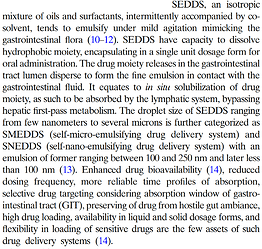All good. I was being pedantic, too. I think our industry needs more pedanticism.
However, what I wrote is correct. It’s a common misconception that microemulsion = nanoemulsion. As I described above, nano is a specific thing, as is micro. Particle size isn’t the determining factor between microemulsion and nanoemulsion. Many scientists also get this distinction incorrect.
SEDDS is a different topic. SEDDS are microemulsions because they are typically prepared using low-energy methods (chemical rather than mechanical). However, once the SEDDS are diluted under light agitation, they can be defined as SMEDDS or SNEDDS based on their particle size.
The particle size of microemulsions and nanoemulsions can be <100 nm. Critically, unlike SEDDS, that particle size is present in microemulsions and nanoemulsions before dilution. And upon dilution, the particles are not reduced in size; there are just fewer particles.
So:
- Microemulsion ≠ nanoemulsion
- Microemulsion = SEDDS, SMEDDS, and SNEDDS
- SEDDS = SMEDDS & SNEDDS
- Nanoemulsion ≠ SNEDDS
SEDDS were primarily designed to ‘self-emulsify’ in the GI tract’s gastrointestinal fluid after ingestion, increasing drug bioavailability and the reliability of absorption profiles. The GI tract’s microflora provides light agitation required for the self-emulsifying process within the GI tract. So, for SEDDS, particle size is the determining factor once they are diluted. However, that does not change the distinction between microemulsion and nanoemulsion.
For oral cannabinoid delivery in liquid-filled capsules, SNEDDS is probably the best choice. But for beverages, gummies, and other infused products, SEDDS don’t have much value, IMO. For beverages, transparent microemulsions, nanoemulsions, or extruded liposomes with particle sizes <40 nm are probably best. Regarding particle sizes for gummies and other infused edibles, I haven’t yet looked for published research on optimal particle size. Still, I imange it doesn’t matter a lot consdiering the emulsion is within a solid substance.
See:
Nanoemulsions versus microemulsions: terminology, differences, and similarities
Self-Emulsifying Oral Lipid Drug Delivery Systems: Advances and Challenges
Self-emulsifying drug delivery systems (SEDDS): An update from formulation development to therapeutic strategies
Lipid-based emulsion drug delivery systems — a comprehensive review


